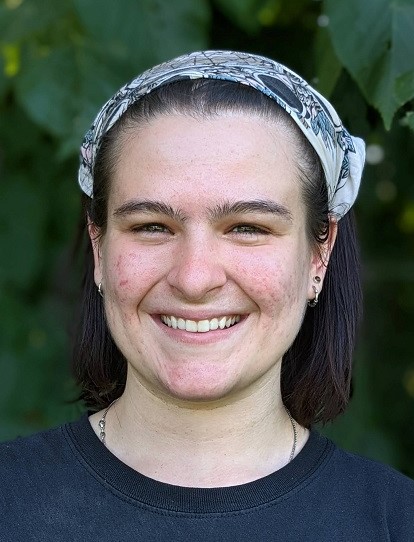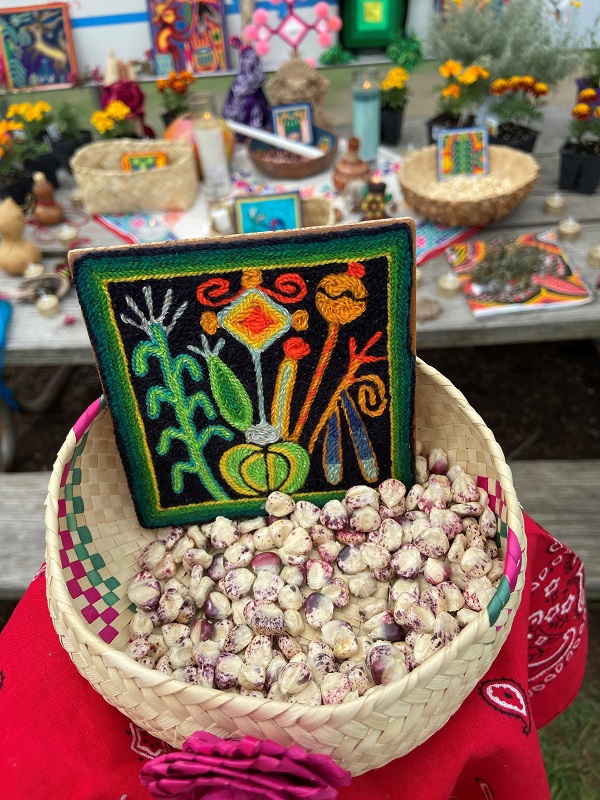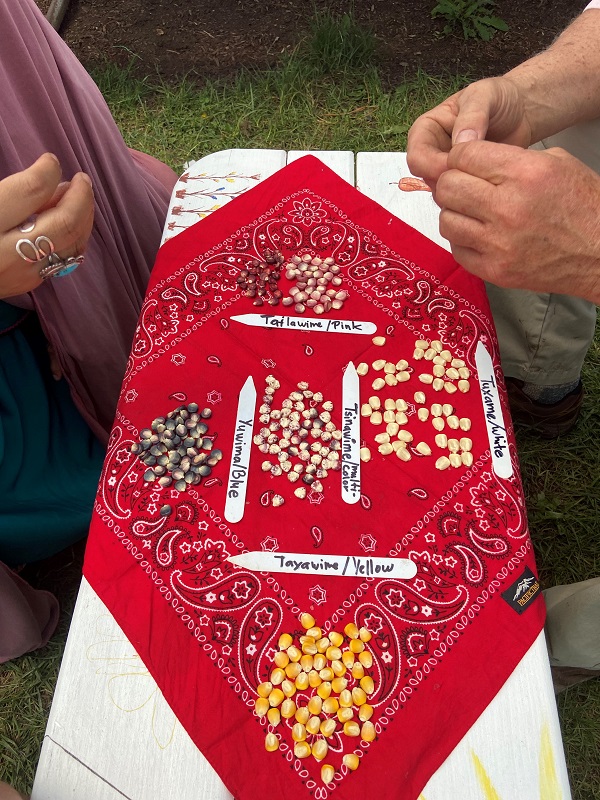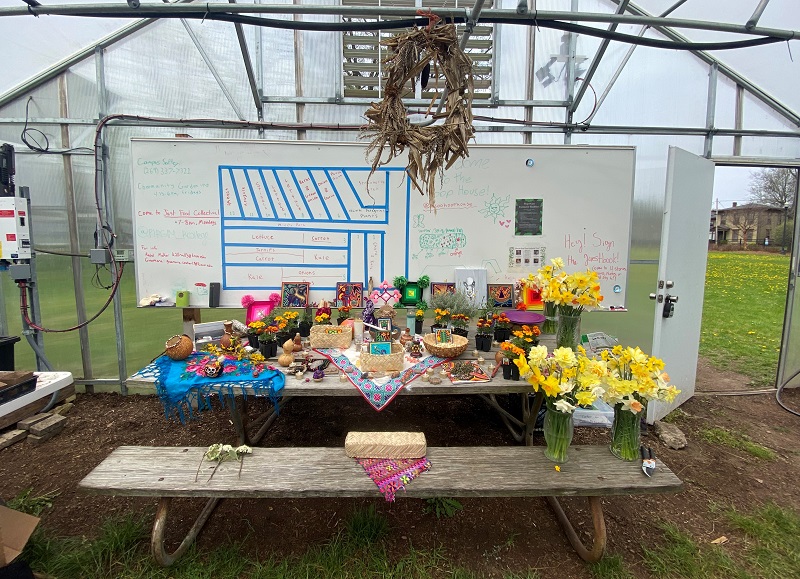Seed stewardship lies at the heart of two summer Environmental Stewardship fellowships at Kalamazoo College’s Hoop House this summer.
Maeve Crothers ’23 and Nora Blanchard ’23 are completing fellowships through the Larry J. Bell ’80 Center for Environmental Stewardship that will form the basis of their Senior Integrated Projects this fall.
An online seed stewardship course is helping the students develop skills crucial to their projects. Crothers is part of a seed collaborative’s efforts to create stable tomato seeds, while Blanchard is cultivating corn gifted from the Wixárika community in Mexico to Cyndy García-Weyandt, assistant professor of critical ethnic studies.
“A big part of what we’re learning this summer is how to be good seed savers and seed stewards,” Blanchard said.
The course, Seed Seva, is designed and taught by Rowen White, a member of the Mohawk community called Akwesasne, with traditional territories in what is now New York state and Canada. White lives in northern California, where she runs Sierra Seeds.
“We’re thinking about how our relationships with plants are so intertwined,” Crothers said. “Plants adapt to the environment and the conditions we put them under, but Rowen has also talked about how humans have been adapted by plants to take care of them. It’s very much a symbiotic relationship.”
Summer Fellowships at K
Several Kalamazoo College students are completing summer 2022 Environmental Stewardship fellowships through the Larry J. Bell ’80 Center for Environmental Stewardship and we are featuring some of their projects at kzoo.edu. Read on to learn about some of the environmental fellowships making a difference in the local community.
Open-Source Tomato Seed Initiative

Environmental Stewardship fellowship and a
fall Senior Integrated Project on a collaborative tomato
growing project with a local seed company.
This is the second year Crothers has participated in an open-source tomato seed initiative with Nature & Nurture Seeds for an Environmental Stewardship fellowship. The project is an Organic Research and Education Initiative grant-funded collaboration between the Organic Seed Alliance, the Seed to Kitchen Collaborative and Seedlinked.
Her advisor, Mellon Fellow for Experiential Learning Amy Newday, connected her with the project to de-hybridize Juliet tomato seeds.
While hybrid plants are not inherently bad, Crothers said, their seeds are unstable because of the mix of genetic material. If you save the seeds and replant them, you may end up with very different and unpredictable produce the following year.
“We’re working to create a stable variety of Juliet tomatoes that can be planted and grown by everyday people, by home gardeners,” Crothers said.
Erica Kempter of Nature & Nurture Seeds performed the initial cross of the tomato varieties Maeve is growing. The Seed to Kitchen Collaborative is managing the collaborative trials and collecting both the data and the seeds from the plants that are selected for advancement to the next generation.
During summer 2021, Crothers was growing the third generation of the plants. She grew 15 different plants, and selected the best three—based on a combination of health, productivity, disease resistance, taste and appearance—to return to the project.
“We had some weird tomatoes last summer,” Crothers said. “We had 15 of the plants and they all grew completely different tomatoes. Some of them were small and round. Some of them were long and yellow. Some of them were striped; some weren’t. And they had very different tastes. Some of them were really good. Some of them were mealy and gross.”
The Seed to Kitchen Collaborative grew a fourth generation in greenhouses over the winter, and this summer, Crothers is growing a fifth generation. She has five plants each of three different varieties, of which she will pick the best to send back. Since there is still a fair amount of variety in the plants, Crothers expects the project will need a few more generations before they have a stable variety of seeds that can be planted and saved year after year.
Crothers’ work is part of a community-based seed project, with other growers throughout the Midwest taking part in the same work with tomatoes. The project is key to food justice efforts, as communities that strive for food sovereignty and independence from large food systems require reliable seeds. The fellowship has also been a learning experience for Crothers.
“I came into this fellowship last year with basically no gardening experience other than my couple months that I had worked with the Just Food Collective in this space, because we didn’t really ever have a garden growing up or anything,” Crothers said. “I have learned so much about what plants look like and what to do for them and how to tell if a plant is struggling, has disease or nutrient deficiency or anything. I’ve definitely learned a lot about nature and how healing it can be to work with plants and work in the dirt and just be.”
Corn Cultivation

Amy Newday also advises Blanchard and encouraged them to apply for a fellowship to support their work with corn gifted to Cyndy García-Weyandt, assistant professor of critical ethnic studies, by the Wixárika community in Mexico.
“That was a tremendous, amazing gift that was given to us,” Blanchard said. “We now have the responsibility of caring for this corn and doing the best that we can to build a relationship with what we call Our Mother Corn now that she’s here.”
There are five different varieties within the corn—multicolored, yellow, sweet, white and blue—and their arrangement and cultivation are significant for the Wixárika community.
“Not being a part of that community, it’s been really important for me to become familiar with those traditions” with a lot of help from García-Weyandt, Blanchard said. “That’s what the corn is familiar with and needs. We’re learning how Our Mother Corn grows here and I’m learning how to communicate with her and become really observant about her needs.”
García-Weyandt led Blanchard in a traditional seed-planting ceremony and blessing of the seeds in the spring. Blanchard is also learning different techniques, such as hand pollination, and keeping the Wixárika community informed about how the corn is developing.
The hope is that the plants will produce ears of corn. Although they have not yet formed a tassel and silk, which normally would happen at this time, Blanchard remains hopeful.
“Sometimes when you grow a plant that’s from southern areas in the north, the pollination date can move into fall,” Blanchard said. “This could be something that is going to take a while.”
The interaction between culture and cultivation fascinates Blanchard, who marvels that you could find one variety of multicolored corn grown all across a country, yet in different areas, people will have selected for different colors, flavors, sweetness and use.
“That’s why it’s so important to understand and be willing to learn about the community this Mother Corn is coming from,” Blanchard said. “When you look at this corn, the colors and everything are because of the community that has selected for it, and it tells you something; it tells you a story, and it’s amazing. I can’t wait to get different ears and see all the colors and what they look like. I’m excited for that.”
Blanchard plans to hold a harvest festival for the corn in the fall.


Senior Integrated Projects

Blanchard and Crothers will be writing fall SIPs based on their summer growing experiences.
“I want it to be the documentation of the agency of Our Mother Corn throughout this experience this summer, helping her grow,” Blanchard said. “I also want to do a personal side of that, too, where I’m also documenting my own growth and change over the summer in relation to the corn.”
For Blanchard, an anthropology and sociology major, the community aspect of cultivation is key.
“Community is something I’ve been thinking about a lot this summer and how that’s a really big part of the work we’re doing and food justice,” Blanchard said. “How do we meet other people who are doing the work we’re doing, and how do we build relationships with them and learn about these structures and people and movements within our own community that we can support or that can support us? This corn is a result of her culture and that’s a really wonderful thing. It’s such an important thing to maintain. What does it mean for the corn to be growing on this land in Michigan and how do I maintain this relationship with the Wixárika community in the future?”
Crothers, a political science major with an environmental studies concentration, will use the tomato project as a jumping-off point to dive into the origins, history and cultural differences in various types of seed stewardship.
“I’m also interested in the legality of it, like how can you put a patent on a living thing and call it intellectual property?” Crothers said. “People can get in trouble for growing their own corn next to genetically modified corn; if it pollinates their corn, they can get sued for growing corn they don’t have the right to. I’d like to dive a little deeper into that and also how we can work together to save seeds and create new varieties that can be available for everybody.”
Both students have found a passion for food justice and food sovereignty through their involvement with the Just Food Collective and the Hoop House.
“Those considerations are what drew me to the Hoop House in the first place,” Crothers said. “Then I fell down the rabbit hole of realizing it’s such a complex problem; it’s related to seeds, to income inequality and housing inequality and so many things. There’s so much to unpack. Seed saving has its own complexity, but for me, it’s been an element of food justice to focus on that has helped me learn more about the bigger picture.”
“The way I approach and understand food sovereignty and food justice are always changing,” Blanchard said. “I don’t know how you would do this work without having that be the forefront of what you’re thinking about and considering all the time.”

